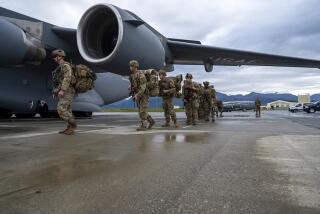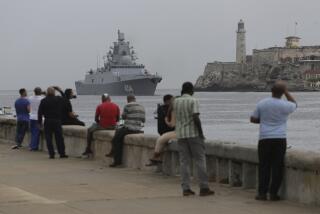U.S. and Russian Subs Collide Under the Ice in Barents Sea
- Share via
WASHINGTON — A U.S. nuclear submarine collided with a Russian ballistic missile submarine over the weekend, the second such accident in 14 months, naval officials from the two countries announced Monday.
The incident occurred late Friday night PST under the ice in the Barents Sea, just north of Russia, where submarines of the two navies have been tracking each other for years. The American vessel involved was the Grayling. The Russian sub was not identified.
Both sides agreed that damage to the vessels was slight. They emerged intact, with no damage to their nuclear power plants or weapons systems. Officials said both submarines were returning to their home ports under their own power.
The United States immediately expressed regret over the incident, but officials said the statement was intended only as an act of courtesy and did not mean that Washington was accepting any blame.
George Stephanopoulos, President Clinton’s communications director, said the Navy is investigating the incident but declined to comment further. No injuries occurred, Stephanopoulos said.
U.S. officials said that the incident apparently was not related to the current political tensions in Russia, where Russian President Boris N. Yeltsin is locked in a struggle for power.
But the two governments were sharply divided over who was responsible for the collision, which came while the Grayling was attempting to monitor movements of the Russian sub.
While Moscow blamed the U.S. vessel, Pentagon officials said that evidence so far suggests that the Russian submarine may have struck the American boat. The Russian news agency Itar-Tass said that the Russian vessel’s bow was damaged, suggesting it hit the U.S. submarine front first.
Submarines of the two countries used to provoke each other intentionally, but with the end of the Cold War such practices are supposed to have been abandoned.
Even so, U.S. officials conceded that the incident was troublesome, if only because of the frequency of such accidents in recent months. The Baton Rouge, a nuclear submarine, hit a Russian sub in that same area in late 1991, also causing minimal damage.
U.S. military authorities said that despite the sophisticated sonar equipment that the submarines of both navies carry, such accidents are easy to envision in the ice-covered Barents Sea, where sonar waves can become distorted.
The Russian navy issued a statement saying that the commander of the U.S. sub had been “attempting to keep watch (on) our submarine (when it) lost hydro-acoustic contact” with the Russian vessel.
The Russian statement said that the U.S. commander, “maneuvering illiterately (sic) . . . led to the dangerous situation which caused the collision, whose consequences could have been far more serious.”
U.S. officials made no apologies for the Grayling apparently tracking the Russian vessel, which they described as one of the newest and most heavily armed in the Russian fleet. With those kinds of weapons, one official said, “it would be only prudent for us to want to know where it is.”
According to Jane’s Fighting Ships, a standard reference work, the Russian boat--which Moscow described only as a Delta III-class vessel--is 508 feet long, contains a crew of 130 men and carries 16 SS-18 multiple warhead nuclear missiles, with a maximum range of 5,000 miles.
The Grayling, by contrast, is an older, Sturgeon-class attack submarine that is 292 feet long, 32 feet wide, weighs 46 tons and carries a crew of about 140 men. Its job is to track other subs and destroy them if necessary.
More to Read
Sign up for Essential California
The most important California stories and recommendations in your inbox every morning.
You may occasionally receive promotional content from the Los Angeles Times.













